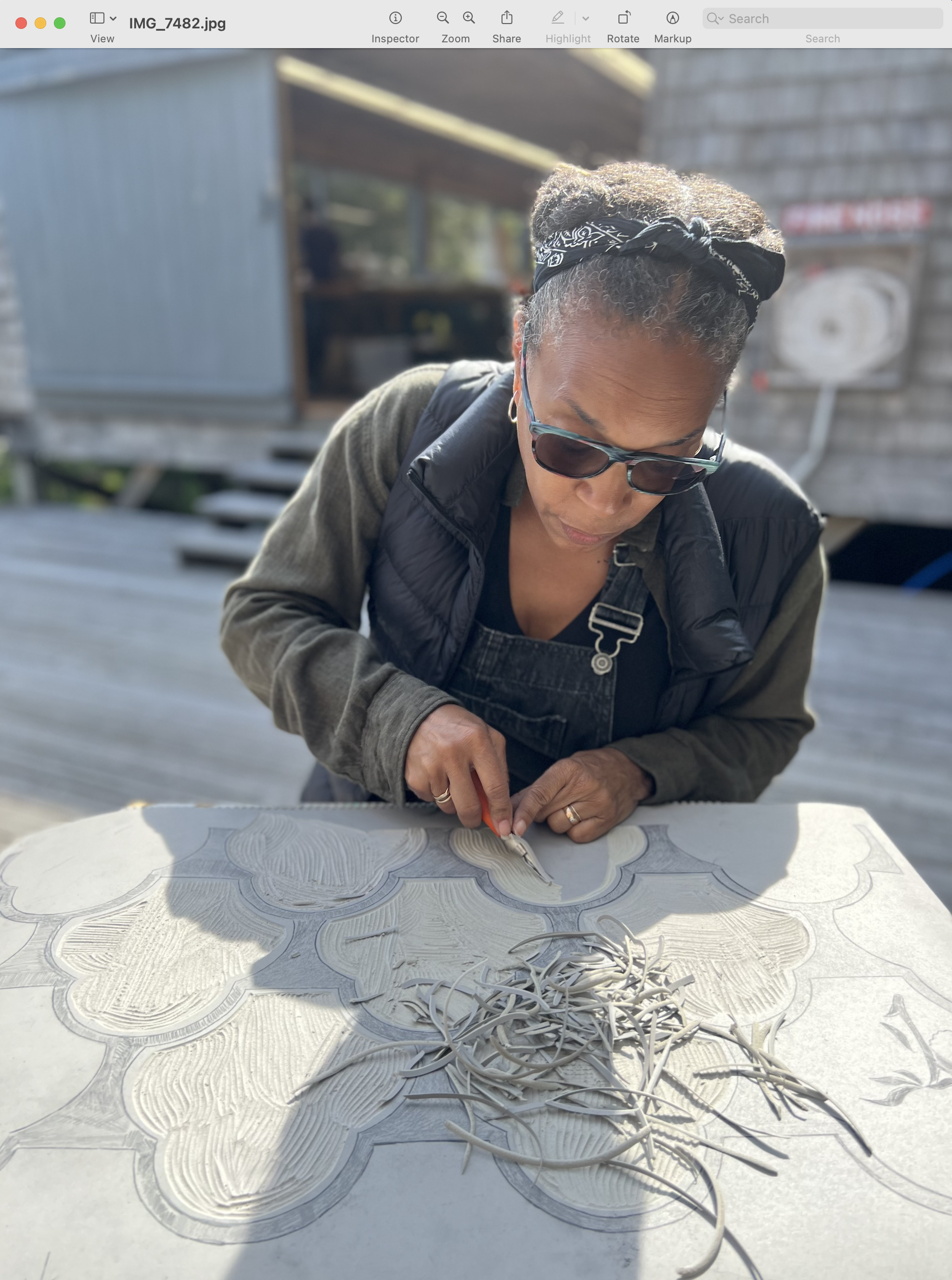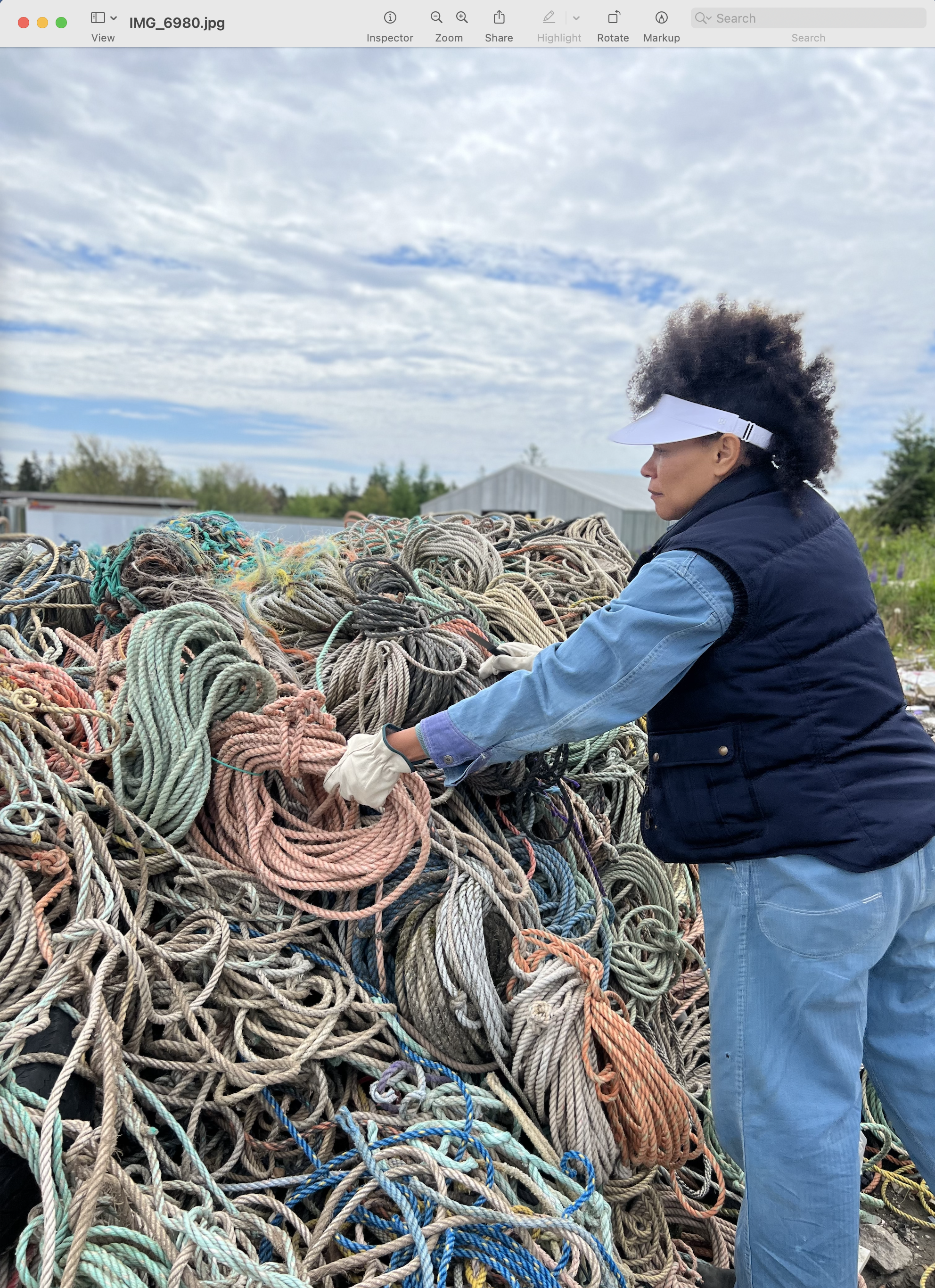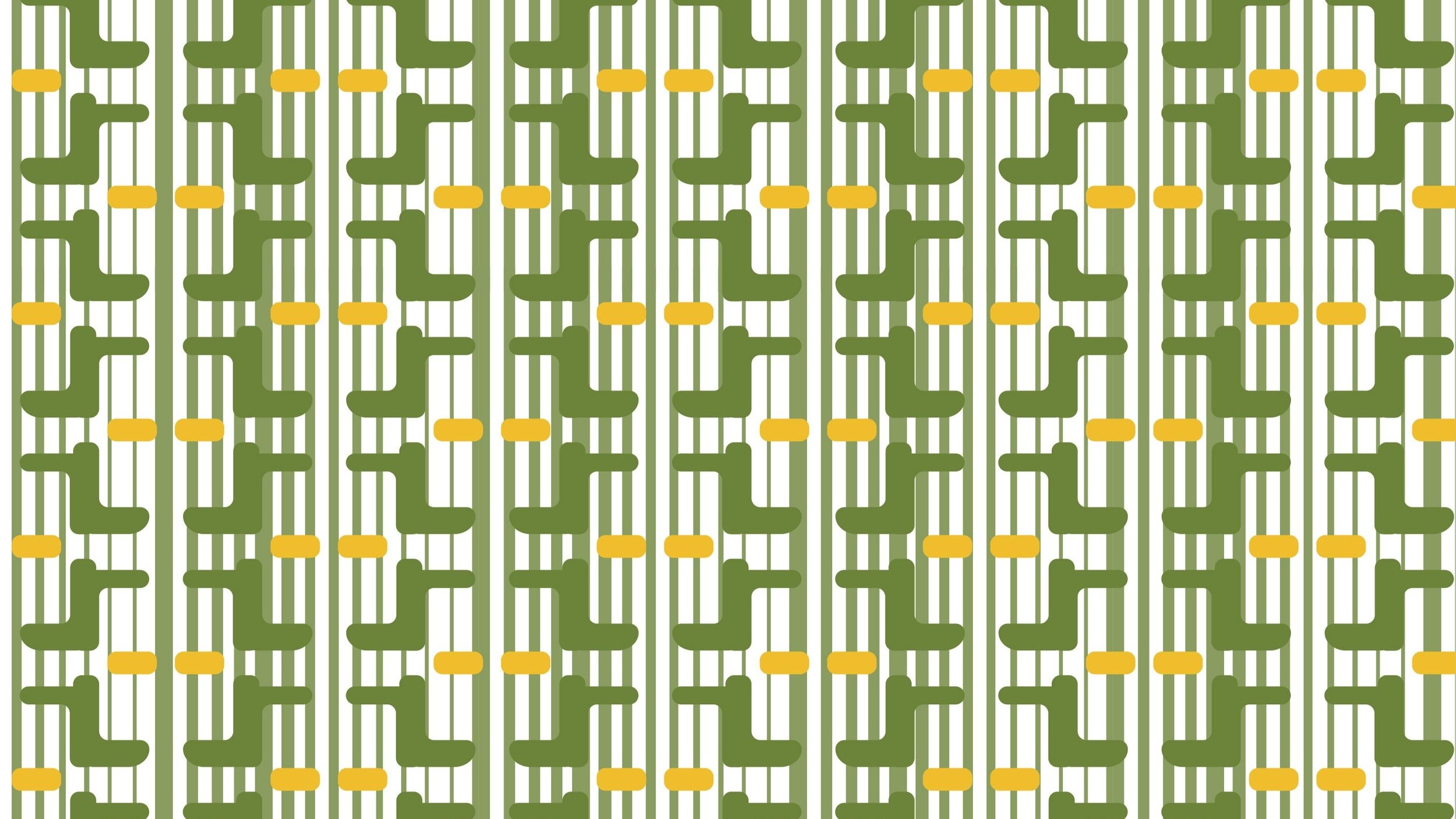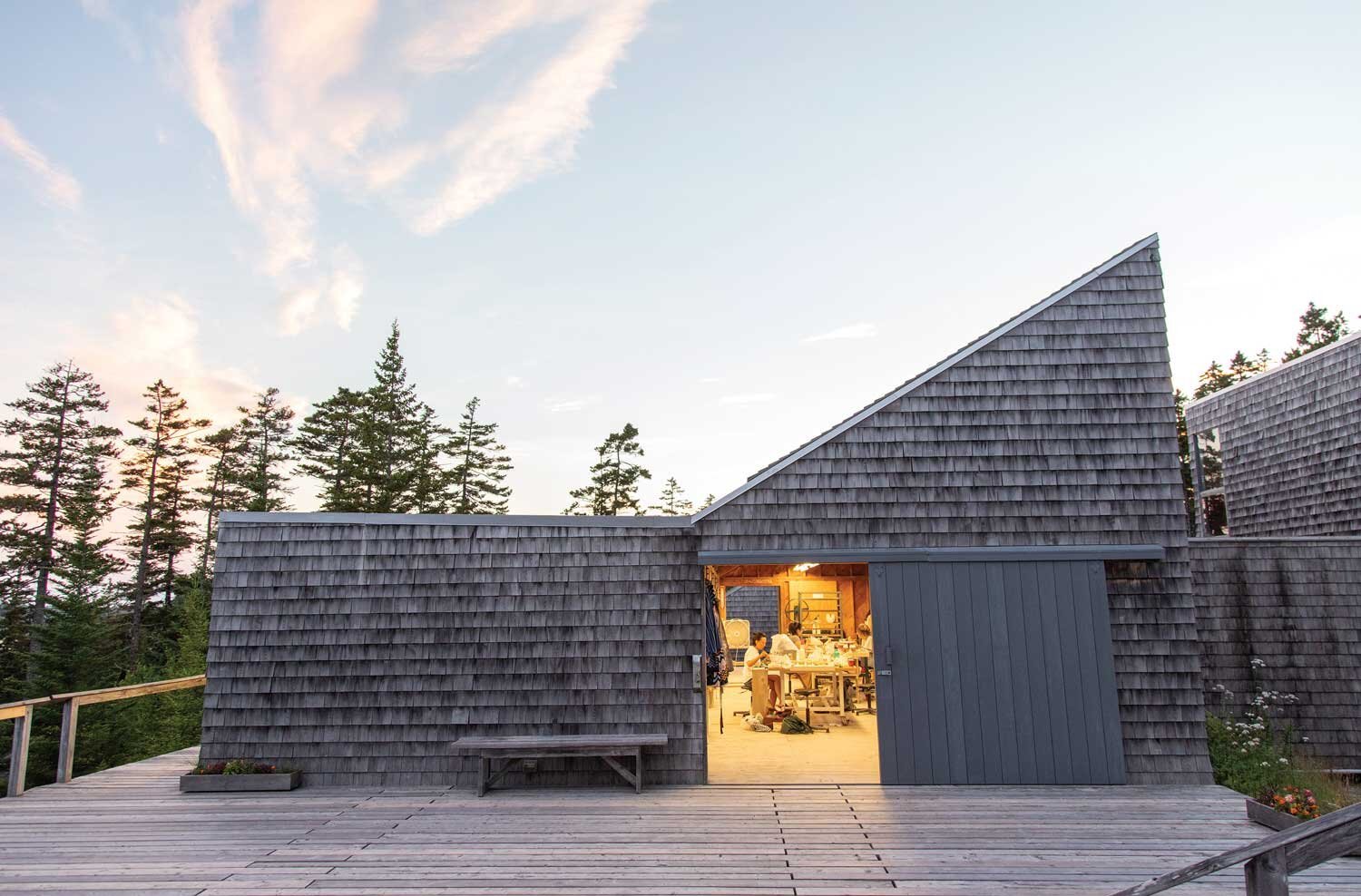
RESIDENCY & WORKSHOPS
EXPANDING PROFESSIONAL PRACTICE
BADG Residencies and Workshop at Haystack offer Black makers the chance to join a community and expand their practice outside the studio.
The next application cycle for 2026 opens in Winter 2025.
Funded by Haystack School of Mountain Craft

“My time at Haystack was more illuminating than I ever expected. Not only did I meet some incredible artists from across the world, some of whom I’m proud to now call friends, I got to experience the magic of unfettered artistic endeavor. Being able to simply focus on learning a new craft has empowered me to recreate the Haystack experience at home — including the impeccable food!.”
— Sherrod Faulks, Ceramic Artist

Past recipients of residencies and workshops
BADG Residencies and Workshop at Haystack offer Black makers the chance to join a community and expand their practice outside the studio.

-

Karen Revis
Harlem, NY
Reparations in Public Space is an exhibition that strives to change spatial narratives through a series of speculative design ideas that transform spaces of trauma into spaces of healing and liberation.
-

Kelly Marshall
New York, NY
JUXTAPOSE is a new way of doing installations for shows and museums where we give credit to unnamed creators, their culture, their skills and unique contribution while we use the references as a way to create new things that can be attributed back to the Black culture.
-

Nina Cooke John
Chicago, IL & Providence, RI
(Un)Imagined Lives is a multimedia film project using co-authored ethnographic research from areas of contested ownership and colonial occupation to create both a physical and digital archive concerning the spiritual offspring of the Queer Black folx lost during the Middle Passage.
-
Shari Francis
Brooklyn, NY
-
Leila Kharem
White Plains, NY
-
Sherrod Faulks
VA
Overview
The Creative Futures Grant supports projects celebrating Black diasporic expression in craft mediums by a Black student craftsperson
-
We are accepting applications from Black-identifying graduate students currently enrolled in MFA programs at US-based institutions. US citizenship is not a requirement for eligibility but you must have a US-based bank account for award disbursement.
Applicable Disciplines: All craft disciplines, including fiber arts, ceramics, furniture/wood working, metalworking/jewelry, glass, paper/book arts and textiles/wearable arts.
This grant is intended for projects celebrating Black diasporic expression and is not for business operations
Applicants must be able to receive taxable income in the U.S. and report this grant as income. *US bank account is required
If an applicant has been previously awarded a BADG grant they are not eligible to apply.
-
The application closes on September 22, 2025 at 11:59 P.M. Pacific Standard Time
Announcement of the 2025 Creative Futures Grant Award Recipient will be made
on or before October 28, 2025.
-
For any further questions, please feel free to contact us at grants@badguild.info

FAQs
-
Why is this only for craft artists and not inclusive of all design fields?
Eligibility is limited to craft artists because this grant is funded by a generous donation from Maxwell Hanrahan Foundation whose primary philanthropic focus is supporting craftspeople within the field of craft.
Are architecture, Industrial or fashion design included as craft disciplines?
No.
What is the difference between fashion design and fiber or textile arts?
Both involve working with textiles and can share similar techniques, however, fashion design aims to create wearable and marketable garments while fiber arts focus on artistic expression through textile mediums.
The end products of fashion design are intended for the consumer market, while the outcome of work by fiber artists are often created for aesthetic appreciation, cultural expression or conceptual purposes.
I work in several craft disciplines, but you are asking me to select a single discipline on my application. Will all of my work be considered or do I need to limit work samples to my primary medium?
All of your work is eligible for consideration but we would like you to specify the discipline that you work the most in. You can still include images of your work in other disciplines as long as all the work you share falls within the field of craft.
I use a craft medium, but I make conceptual work. Am I still eligible to apply?
Yes. While there is often a separation between fine art and traditional craft, the Creative Futures Grant Award will consider contemporary and traditional craft practices eligible for the award. When the primary intent is functional (e.g., pottery, quilting, furniture), the work is more likely to be seen as craft. If the intent is to express ideas, emotions, or concepts without a functional purpose, it leans more towards fine art. We are prepared to celebrate both approaches within the field of craft.
Contemporary artwork made with traditional craft materials can be considered both craft and fine art, depending on the context, intent, and reception. The boundaries are increasingly fluid, and many contemporary artists embrace this fluidity, challenging conventional distinctions and enriching both fields in the process.
-
What should my ten images include?
The applicant may use the image requirement as they see fit to represent their best work. They may choose to show multiple perspectives of a single piece or a range of different works within one of the disciplines, or the multidisciplinary, categories.
You may include one or more images that show multiple pieces/elements that are meant to be viewed together as a single work, or to show one or more pieces as installed in a gallery/space. Composite images (separate images combined into one image) are not acceptable.
Do the work sample images need to have a common theme or be a project, or is it just a cross-section of an artist’s work?
The applicant needs to submit the images that, in their opinion, best shows their work - whether it be in a series, or a cross-section of work. It is recommended that artists submit works that are conceptually related.
-
Who will select the winners?The recipient will be selected by a jury of three professionals from across the United States, currently active in the field of craft.
What is the selection criterion?
The jurors will make their selections based on artistic excellence and the evidence of a legacy as described in the responses application questions that reflects and represents the diversity of the field Black Diasporic expression across all artistic modes while addressing and correcting inaccuracies and omissions in craft and art history.
Could I ask how my images are viewed? What is the screen/projected size? Will they be viewed two or three at a time?
Images are viewed typically on a computer screen by each individual juror. For each submission, they see thumbnails of your ten images, and enlarge each to be pretty much a full-screen size.
-
What is the award?
The Creative Futures Grant are two $5,000 cash prize intended to support projects that Black students in craft may want to do but are not necessarily supported to create at their educational institutions. The grant seeks to move students toward actualizing all the phases of a creative project.
If I am the winner, what will I receive?
The recipient of the award ward will receive two payments of $2,500 deposited by ACH to a US bank account. The second payment is sent after the 6 month progress report is submitted.
If I am the winner, what can I spend the money on?
The Creative Futures Grant is intended to support initiatives that demonstrate innovative models within the recipient's field of expertise.
BADG hopes the $5,000 grant will be directed towards endeavors that forward the recipient’s craft practice and legacy building by covering expenses related to creation of new work for your thesis exhibition, a permanent public art installation, a body of work outside of your graduate coursework , travel to support research connected to the creation of work, and or the continuation of a project you are already engaged in (as a part of or outside of your school work), but winners are not required to submit their use of the funds for approval.
The Creative Future Grant Award Recipient should note that the award money constitutes taxable income, and should file accordingly.
If I am the winner, what am I obligated to do?
The recipient is required to submit a one-page progress report with images (if appropriate) on how they used the fellowship winnings no later than February 15, 2026.



-

Abena Otema Danquah
Architecture, Rhode Island School of Design
The Kaya Pavilion proposes a space for learning, gathering, play, and rest. Proposed to be installed in a city where public space is utilized as an abstract concept, this project will reveal the impact of planning for human encounters and the coexistence of multiple publics.
-

Janiya Douglas
Art History & Curatorial Studies, Spelman College
The project aims to cultivate an institutional space that centers and reflects a consciousness solely rooted in the experiences of Black Americans in the South. The architecture of Souf, a hub of Southern Black Intellectual Thought, will exist as a campus that embodies the cultural aesthetics of Southern Black expression. Janiya proposed an architectural design for a community-arts institution that centers on the ancestral experiences and lineage of Southern Black Cultural expression.
-

LaRissa Rogers
New Genres, University of California Los Angeles
Exploring the dual nature of flight and migration as a means of survival and preservation, this six-foot soil sculpture will pay homage to the interconnected histories in the soil and land from which they are created. Mimicking the appearance of a core sample (a section of a naturally occurring substance such as earth or corporeal matter), the sculpture will speak particularly to diasporic resilience through the lens of place and belonging. A video will be projected onto the sculpture to draw micro and macro parallels between objects, images, family narrative, historical moments, landscapes, and the afterlife of slavery.
-

Neysa Wellington
Photography, Tyler School of Art and Architecture, Temple University
"Ena D)" a mother's love is an exploration of the mother's role in different family dynamics throughout the African continent and the diaspora. This visual storytelling project will serve as a catalyst for healing and understanding the role of mothers and the value of becoming your own.

MAKE A DONATION TODAY

